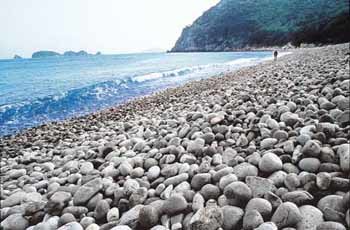Edgeless Pebbles, `Round` Hearts

There is a paved road into the town and cars also come as far as to the port, but nonetheless, it still is remote and obscure. Public bus comes only once a day and although Internet connection exists, transfer line is difficult to link.
It has been a long time since it became almost like inland, as two bridges were built from Tongyoung. Therefore, deep isolation and loneliness of islanders could have disappeared.
But this is originally an island in the middle of the sea with land on its back. Yeocha Village (Yeocha-ri, Nambu-myeon, Keoje) kept its people from the outside world, so that the village people still seem to have the scent of sea in their actions and words.
It is almost at the bottom of Keoje Isle. Pavement ends at Yeseo and rough road passes through the forest behind the village and meets National Route 14. Such isolation kept the village obscure, while Hakdong, which is only 10 minute-drive away, became famous along with Oei Isle’s maritime farm. Nonetheless, the natural beauty still attracts a number of outside visitors.
Northen Keoje Isle’s Mongdol Coast. It certainly was an attraction that would offer enough to fill inlanders’ tireless curiosity. Among the countless number of pebbles, there was none that had edges. Whether big or small, all were round and smooth that they looked like my 3 year-old child’s light skin.
Sea wind was wild enough to make me understand how these pebbles became so round. Waves were as wild as the wind that made them.
I came across a little town called `Hangae` behind the forest, where two or three households could be seen, as I was walking along the Mongdol Coast. The place had a few palm trees on the hill that overlooked the sea between valleys. It seemed perfect for seaside villas.
The rough road that began from Yeocha Village passed through the village entrance until Kamaguijae. On the left side of the road, is high cliff. There were the two villages, Hangae and Yeocha, Mongdol Coast, and the deep blue southern sea under it.
I remember strong wind at Kogae-maru, where my body almost flew away. There was breath-taking scenery of the southern sea before my eyes. I could see Daebyung Isle on my left and Maemul Isle on my right. A small island in front of them is called Eoyu Isle. So-Byungdae Isle, where nobody lives in, is located in front of it, and Kawang Isle is seen on its right back.
On the way back to the village, I met a woman diver, who was carrying a big basket on her head. I greeted the smiling diver (Jung Hyun-Yeon. 49) by asking how much she had caught. She then answered, `Drop by later`, pointing at a house. It was 2-storey `Yeocha Raw Fish` (055-633-1332), which also offers lodging.
I was thinking about a drink after walking anyways. I had the meal in the warm main room with delicacy that could only be tasted on the shore. I asked the husband (Kim Yong-Deuk. 54) for some island stories. The couple was natives of Yeocha Village. They told me that wild seaweed grows 3-4 meters under the sea, and is collected on islands or seashore. In December, all the village residents go out to the sea to work in the cold to cut other water plants so that seaweed can grow. Harvest time for seaweed is from now on.
Although it is remote, the couple said that tourists fill the town in the hot summer. Mongdol Beach would be covered by tents so that even fishing ships have to stay away from that area. But on the day, the village was as disengaged as it could be. As I fell asleep listening to waves, I also woke up with the waves. The only difference in the morning was that there was sound of bird. I also could almost hear the pebbles rolling…
summer@donga.com



![“국힘 41% 득표가 졌잘싸? 되레 독 될수도”[정치를 부탁해]](https://dimg.donga.com/c/138/175/90/1/wps/NEWS/IMAGE/2025/06/04/131745994.1.jpg)



